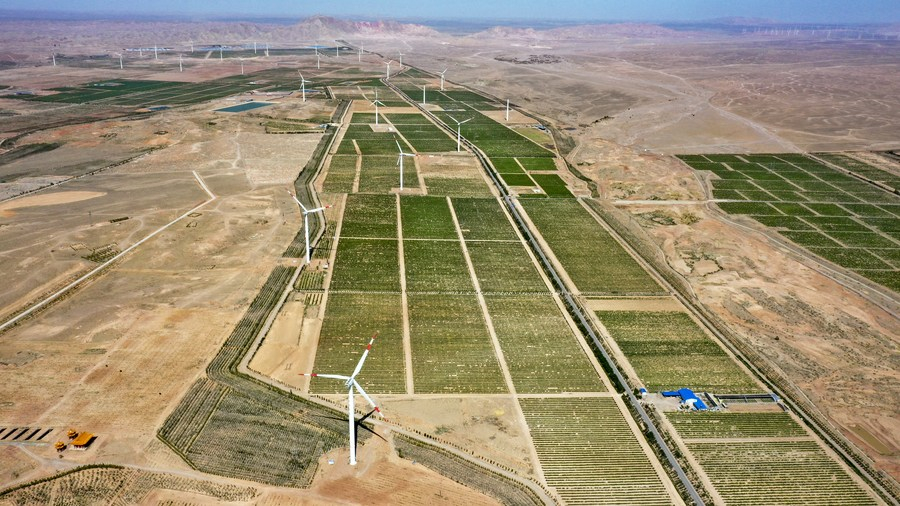Yellow River gorge city morphs into eco-friendly wine-producing area

This aerial photo taken on June 7, 2023 shows a wine grape planting base of Xige winery in Qingtongxia, northwest China's Ningxia Hui Autonomous Region. [Xinhua/Feng Kaihua]
YINCHUAN -- During a wine festival held in May, many visitors and tourists got a chance to see an ecologically sustainable wine industry base in northwest China's Ningxia Hui Autonomous Region, which was once an agricultural zone along the Yellow River, famous for irrigation constructions dating back over 2,000 years.
The city of Qingtongxia, where the base is located, has grown into a booming destination for tourists, wine brewers and agricultural companies. It is also an eco-friendly garden city thanks to decades of efforts in protecting the Yellow River environment and relevant cultural relics.
Taking a trip on boats along a breathtaking gorge on the Yellow River surrounding the city, tourists can enjoy clean water and green hills dotted with historical sites.
Yang Dongxia with the city's water resources department said that tourists who visit the city are often amazed to find that the irrigation constructions dating back about two millennia are still functioning and continue to serve the local farmlands and vineyards.
"Qingtongxia has comprehensive historical value in various aspects including military matters, irrigation and farming. It is also among China's earliest agricultural zones along the Yellow River," said Yang.
"You can see irrigation engineering projects built during different ancient Chinese dynasties here, down to the latest dam built in the 1950s," Yang added.
Each of the dynasties has left behind steles recording the dates for the construction of their respective irrigation projects. An iron ox statue believed to have been made during the Tang Dynasty (618-907) was also found in the river section of Qingtongxia about 70 years ago. Duplicates of this statue can now be found in Qingtongxia and the regional capital of Yinchuan.
"Originally designed for protecting the Yellow River from the scourge of floods, the statue is a symbol of the frequent local agricultural activities in ancient times and has witnessed the area's great transformation from backward farming fields into a modern city led by its burgeoning wine-making sector," Yang said.
The entire northern and central parts of Ningxia, including the city of Qingtongxia, have recently undertaken ambitious initiatives to transform themselves into a prominent national wine-producing hub, aiming to stimulate local economic growth and revitalize the rural areas.
Since 2020, Ningxia has been tasked by the central government with building itself into a pioneering zone in the Yellow River basin in terms of ecological preservation and high-quality development. It has been upgrading the local environment over the past few years by shutting down factories and mines causing heavy pollution, purifying water resources and disposing of waste in a comprehensive and scientific way.
The wine industry is one of the fastest growing industries in Ningxia and its wine products are being sold all over the world, while also proving very popular with Chinese consumers.
Qingtongxia and many other cities in the region are now attracting domestic and foreign investors and talents to foster a truly internationally competitive wine industry.
"We are optimistic about the region's future of becoming a world-class Yellow River wine production center because our land is good for planting high quality grapes," said Dou Xiaoming, a local wine producer who has been making wines for over 10 years in Ningxia.
Nicolas Billot-Grima, a 57-year-old wine expert from France, said the region's abundant sunshine and arid climate combine to create an optimal environment for grape plantation, with minimal interference from pests and diseases, while the local diversified and fertile soil can further enhance its suitability for cultivating various grape varieties.
























